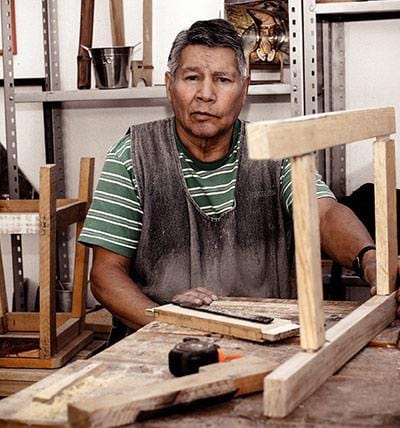When crafting the perfect set of drink-saving heroes, choosing wood isn't a joke. It's a make-or-break deal, my friends! Picture this: you're sippin' on your favorite beverage, the condensation slowly drippin' down the side, and you need a sturdy coaster to save the day. So, let's roll up our sleeves and dive into the wonderful world of woodworking to find out what wood is best for our trusty coasters! We'll explore the likes of hardwoods such as maple and oak, the rustic charm of cedar, and even the humble pine. Prepare to sand, stain, and seal your way to coaster perfection.
Step 1: Choosing the Right Wood for DIY Coasters: Tree Limb or Wood Slices?
Let's dive right into step one of this coaster-making extravaganza: choosing the right wood for our DIY wonders! Now, we've got two options on the table: tree limbs or wood slices. It's like deciding between a wild adventure and a cozy cabin in the woods. If you're after that rustic, natural look, tree limbs are your jam. They come with their bark intact, adding a touch of organic charm to your coaster game.
On the other hand, wood slices give you a smooth, polished surface ready to be transformed into coaster masterpieces. Think about the type of wood you want-maple, oak, or something else entirely. Remember, though, that thicker slices are more crack-resistant, while thinner ones bring a touch of delicacy. So grab your handsaw, secure that wood with a trusty clamp, and let the creativity flow! And don't forget to wipe away any sawdust and smooth out those rough edges with sandpaper.

Step 2: Preparing Your Materials for DIY Wooden Coasters: Dowel, Drill, and Glue
First, grab a dowel, a drill, and some trusty glue. We're going to bring these scrap wood pieces to life. Drill holes in those bad boys and insert the dowels like they're the missing puzzle pieces. This isn't any jigsaw puzzle, though; we're talkin' coaster construction, my friends!
Make sure that glue holds everything together tight because we don't want those coasters falling apart on us. Once that glue dries up, we'll be ready for the next step. Can you feel the excitement in the air?
Step 3: Creating Your Wood Slice Coasters: Cutting, Slicing, and Drying
Grab your chainsaw or trusty handsaw and slice through that wood like a hot knife through butter. Find the right thickness for your coasters; you don't want them too thick. Watch for any dang cracks or splits while you're at it. Once you've got your slices, lay them out to dry like sunbathing beach bums, allowing all that pesky moisture to evaporate. Patience is key here, folks! While they're drying, take a moment to prepare your work area by covering it with a tarp or newspaper – we don't want any sawdust invading your space. After they're nice and dry, give those coasters a good sanding with a fine-grit sandpaper. Now, it's time to coat them up! Apply a waterproof polyurethane like you're slathering on sunscreen at the beach. Please give them a couple of coats to protect them from spills. If you're feeling extra fancy, you can add epoxy for that glossy finish that'll make your coasters shine like diamonds.
Step 4: Assembling and Finishing Your DIY Wood Coasters: Gluing and Drilling
Gluing and Drilling! This is where the magic happens, so let's get to it. Gather those rustic wood coaster slices you've crafted with love and care. Now, it's time to unleash your inner craftsman. Start by selecting a coaster design that tickles your fancy. Once you've sorted your design, it's time to glue those pieces of wood together like long-lost puzzle pieces. A little wood glue goes a long way, my friends. Please squeeze it and press those pieces together like you're hugging an old friend. Let the glue set and dry the wood like a summer sunbeam. Grab your trusty drill, set your miter saw, and get ready to drill holes like a pro. Remember to clamp a scrap piece of wood underneath to prevent unsightly splintering.
And voila! You've got a set of coasters that'll make your guests' jaws drop. Now it's time to add the finishing touches. Apply a coat of varnish or sealant to protect those coasters from any spills or mishaps that may come their way. Whether you choose a glossy finish or that charming rustic look, it's up to you. And there you have it, my friends, your very own set of stunning DIY wood coasters.
Step 5: Applying the Finishing Touches to Your DIY Wooden Coasters
It's an easy DIY, and I'll guide you through it step by step. First, grab your trusty sandpaper and give those coasters a final sanding, ensuring they're smoother than a silk sheet on a summer's eve. Remember, folks, attention to detail is key here. Next, let's unleash our inner artist and add a touch of pizzazz to these drink coasters. You can get creative and experiment with various finishes. Perhaps a walnut stain to bring out that rich, earthy tone? Or maybe a glossy poly coat for that extra shine? The choice is yours, my friends.
Now, seal the deal using a sealer or varnish to protect your coasters for years. Nobody wants a drip ruining their masterpiece, so take your time and apply that sealant with care. These wooden coasters are not just practical, but also a fun way to add a rustic touch to any space. You can even make a whole set and gift them to your loved ones. They'll be impressed, trust me. So there you have it, the perfect DIY project to learn how to make wooden coasters. It's a step-by-step adventure from a fallen tree to a finished product. Now go forth, my friends, and let your creativity flow.
In A Nutshell
When it comes to choosing the perfect wood for your coaster-making adventures, it all depends on your desired outcome. Softwoods like pine or cedar are great options if you're aiming for a more casual, laid-back vibe. On the other hand, hardwoods like oak or walnut will be your best buddies if you're after a touch of elegance and durability.
Remember, the key here is to prevent cracking and ensure longevity, so choose the wood suitable for your desired thickness and durability. Sandpaper, chisel, and a hexagon shape can work wonders in achieving that flawless finish. So, my friends, go forth and make a set of coasters that'll protect your surfaces and add a touch of natural beauty to your space.

Common Questions
What wood should I use for making coasters?
Well, my friend, it all depends on the look and durability you're aiming for. Softwoods like pine or cedar will do the trick if you're into that rustic charm and going for a more casual vibe. But if you're after that touch of elegance and long-lasting quality, opt for hardwoods like oak or walnut. Remember, the choice is yours, so go with what you always like!
Can I use plywood for making coasters?
Absolutely! Plywood can be a great idea for crafting your coasters. Just make sure you choose high-quality plywood free from voids and defects. Give it a good sanding with some grit sandpaper to achieve a smoother finish, and you'll be well on your way to creating some stunning coasters. Follow some step-by-step instructions, or let your creativity soar!
Do I need to use finer grit sandpaper for my coaster project?
Ah, attention to detail, my friend! When sanding your coasters, starting with coarser grit sandpaper to smooth out rough edges is a great idea. Then, gradually work up to a finer grit sandpaper for that flawless finish. It's all about achieving that smoothness and creating coasters to impress your guests. So don't skimp on the sanding, and let your coasters shine!
ABOUT THE AUTHOR
Aleksandra Djurdjevic
Senior Content Creator
Aleksandra Djurdjevic is a senior writer and editor, covering jewelry, accessories, and trends. She’s also works with services, home décor. She has previously worked as ESL teacher for English Tochka. Aleksandra graduated from the Comparative Literature department at the Faculty of Philosophy in Serbia. Aleksandra’s love for the environment, crafts and natural products over the years helps her continue to be a top expert at Wooden Earth.






